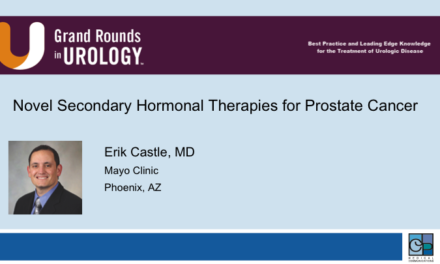Dr. Michael S. Cookson presented “Continuing Care for Your Patients with Metastatic CRPC” at the 27th annual International Prostate Cancer Update meeting on Friday, January 27, 2017.
Keywords: metastatic castration resistant prostate cancer, Docetaxel, Abiraterone, Enzalutamide, Radium 223, Cabazitaxel
How to cite: Cookson, Michael S. “Continuing Care for Your Patients with Metastatic CRPC.” Grand Rounds in Urology. January 27, 2017. Accessed Dec 2024. https://dev.grandroundsinurology.com/continuing-care-patients-metastatic-crpc/.
Transcript
Continuing Care for Your Patients with Metastatic CRPC
I’m going to talk a little bit about sort of pulling things together in terms of the urologist being the primary care giver for men with advanced prostate cancer. Talk about some just models for multidisciplinary care. Talk about the evidence-based therapeutic options in terms of guidelines and then just sort of sum it up.
I think number one is that the urologist should be the primary care giver of men with prostate cancer. And this includes patients as they progress through the disease spectrum, especially those men with castration-resistant disease. Now, patients progress through those spectrums, but they shouldn’t have to progress through specialists. And they need a constant in their life, and they need somebody who can handle the situation from beginning to end. And since we’re the ones that diagnose their cancer, we’re the ones who help them with the early therapy, we’re the ones who understand the progression as they go through management of these different aspects of it, and we can coordinate their care, I think that’s probably our best advertisement for why this should happen.
Lesson number two is we need to establish, organize and manage a multidisciplinary clinic, and this is very important, one that incorporates your available resources that works best in the clinical healthcare environment that you’re in, because we realize that all of us come from different areas and have different available resources for the patients that we care for. This changing landscape in terms of management of these patients, we’re being forced to sort of reorganize the way we help and care for these patients. There are guidelines out there, and we’ll talk about those in a minute, but these allow for various treatment options, but even within the guidelines there’s a lot of different alternative avenues we can pursue, there’s sequencing, and so there is a lot to be gained through sort of a share decision making with a multidisciplinary approach to these patients. And there have been several studies that have shown that patient satisfaction improves, patient disease management improves, and their outcomes improve when they’re cared for in this type of an environment. And this isn’t just unique to prostate cancer, it applies to many other advanced cancers.
So we’ve written about this. These are just more theoretical, but at academic centers we tend to have all-in-one multidisciplinary clinic. And so the patient is in the center, and the patient then goes into sort of a navigation, and we’ll talk about what you need to do that, but it could be a PA, it could be a nurse, it could even be a medical assistant that just that has advanced training. But you try to anticipate what they’re going to need when you see the patient being referred to your center. We review their cases, what we have is a multidisciplinary tumor board. We try to evaluate them for clinical trials, because no matter how optimistic we are about the care that we’re able to give, currently we don’t cure castration-resistant disease. Then we try to personalize their treatment. So when we patients that are coming into our center we try to figure out, what are they going to need? Are they going to need three visits, are they going to need two visits, what’s going to be the best way to optimize their care at that particular time, and then on the return visits too.
So establishing these type of clinics, which are sort of an all-in-one approach may be efficient, particularly helpful from a patient’s standpoint, because they can discuss their treatments with multiple specialists on the same day. Their travel, if they travel a distance that’s reduced because they don’t have to come back on a different day. We find that there’s a higher acceptance into clinical trials. When I was at another institution it was really difficult for us to enroll in some of these clinical trials. We didn’t have sort of a cohesive way to attack the patients. But now we meet, we talk, we discuss in our clinical trial, and our nurses are right there. So everything is right in one center. It just makes it a lot easier to do it.
But we know that this model doesn’t fit all. One size doesn’t fit all, and furthermore, there are a lot of barriers in community practice where an all-in-one clinic may not be the most productive, and there’s financial disincentives, et cetera, so we realize that there has to be other types of care. So there’s alternatives to that all-in-one multidisciplinary, and these include same day different clinic and different day, different clinic models. But the urologist as the primary care taker doesn’t change. And so you just sort of adopt what’s available in your community based on proximity, location, clinic days, schedules, et cetera, but the care can still be sort of coordinated, if you will.
So this is just another model, but it shows you that the urologist, again, is sort of the primary care giver for the cancer component, and then the patients can be referred accordingly. There still needs to be integration of tumor boards. Hopefully, the availability of clinical trials for the patients, and a game plan that’s cohesive. So this is enhanced if you have—and I know some of the large practice groups have a navigator, and that can be really important, because if you have 15, 20 partners in your group, and only 3 of them are doing advanced prostate, that navigator can look across the continuum of your clinic practices and find those patients, and sort of navigate them into the right practitioner. Physician’s assistants are immensely helpful for me. I think nurse practitioners and PAs are really key. They gain great understanding of the way that these treatments are render, and help with everything from the paperwork, to phone calls, to you name it, but they’re tremendously important in this. I don’t think anyone of us can go alone.
The concept of tumor boards is—it used to just be an academic thing, but I think it’s really kind of permeating out into even community practices. But even if you can’t do that, and it’s just a couple of you in a small group, you need to be able to talk to the referring oncologist, radiation oncologist and come up with a plan. The patient understands, it’s a single message and they usually have a lot better buy-in and they’re more understanding. You need a primary care doctor. When I say we’re the primary care givers of their prostate cancer, we’re not the primary care givers of their other medical problems. So you don’t know how many patients that we see referred to us who don’t have a primary care doctor. They got diagnosed, it’s crazy, but they don’t. So we make sure that they have a primary care provider, that that provider knows what we’re doing. We include them in all of the discussions, send them notes and make sure that we have open lines of communication. It certainly helps if you have shared Electronic medical record (EMR), not very possible if they’re small community type situations, but at least you need to fax and make sure that the communication lines are open.
Other things that we like to be able to provide, which I think you can get a bigger center, are things like supportive care, nutrition, pain management, the palliative care things that we as urologists don’t do as good a job for.
Lesson three, if we’re going to do this we have to be aware of the evidence-based therapeutic options and how they fit in. This is an international conference, so many of you may use the European guidelines, AUA guidelines, NCCN, they’re all out there for you. They speak a common language, there’s just a little differences in the way that the data is derived and the way that the message is pulled forward. But I had the opportunity to assist in the guidelines for the AUA on the castration-resistance, so I’ll go over a little bit of that just from the standpoint of managing patients as they go through this sort of disease spectrum that the slide that we’ve seen many times over the last couple of days.
Well, it used to be we had nothing, and then we had docetaxel. But since docetaxel now we have five available therapeutic agents that can be used at different times in the patient’s disease spectrum. So this the way in which these drugs became approved. After docetaxel there was a long period of time where really wasn’t much, and then there was a second line chemotherapy, cabazitaxel. Then we developed immunotherapy with sipuleucel-T, starting getting oral agents, which were originally developed in the post-chemotherapy sort of progression state, then moved into the pre-chemotherapy and the development of radium-223, which you just heard a great talk about in terms of the bone health. But with all of these agents out there and you’re going to take care of the patient, it really helps if you understand how those agents were approved, what the right patient is to offer in the different sequencing. When we developed the guidelines with the AUA we looked at the way the drugs were approved and how they were developed, and it seemed that they followed pretty much these formulas. And one was the presence or absence of metastatic disease. The other was the degree of symptomology and the severity of their symptoms. The performance status of the patient is always important, and because of the way in which historically these things became approved, the use of chemotherapy was an important determinate, at least initially. And so patients were then divided up into these different indices and then there’s an algorithm for how they would be treated.
I’m just going to highlight the things here. This we’ll get back to, but this is the biggest unmet need we have in castration-resistance right now, and these are patients that don’t have demonstrable metastatic disease. So you do a bone scan, you do a CT scan and you can’t find it. With the newer agents that you’re hearing about, we may be better at detecting early metastases, but there’s going to be patients who have only a rising PSA, and for them currently there is no approved agent in that space. So clinical trials are rapidly accruing patients to try and give us this, and it’s very frustrating for the patients who continue on their ADT, have castrate levels, but their PSA is rising, and all we’re really doing is waiting for a radiographic event to occur so we can offer them a standard therapy.
For the index patient 2, these are the patients that are either asymptomatic or minimally symptomatic, but they have metastatic disease, and they’ve not received prior treatment. And for them we have the most to offer really. Currently both oral agents, abiraterone with prednisone, enzalutamide, docetaxel and sipuleucel-T are all available in this space. So this is a place where you have to sort of prioritize, how are you going to treat these patients and individualize it. The registration trial, Cougar 302 was the one that gave abiraterone and prednisone its indication in the pre-chemotherapy space. And it originally was a radiographic progression-free survival, with longer follow-up there was overall survival in a statistically significant fashion as well.
Enzalutamide also did a pre-chemotherapy trial, which many of you now are aware of. It was compared to placebo, again, a statistically significant improvement in survival in patients using it earlier than it was originally approved for in the post-chemotherapy setting. This is the schema for the PREVAIL trial. It had dual primary, co-primary endpoints of progression-free and overall survival and it met both. And this was, again, and oral agent that we could offer patients in this setting.
Docetaxel got it all started. We’ve seen these slides earlier. It was an every 3 week regimen, it was compared to mitozantrone, so again, not to placebo, and it showed a statistically significant improvement, but it was measured in modest months, not years in terms of the actual outcome.
The immune-based therapy, sipuleucel-T, has a pretty narrow window. And so if you’re going to incorporate this into your patient plan you have a limited amount of asymptomatic time to offer it. And so that’s why I point this out, because it’s going to drop off once symptoms become more profound, and that’s one option that will be off the table. But sipuleucel-T was compared to placebo in a 2 to 1 ratio, is showed significant benefit in terms of overall survival for patients. It didn’t change their PSA, it didn’t change their radiographic x-ray so people sort of criticized it or wondered how it worked. But I think we’ve all come to terms with the fact that immune-based therapies may have differences in the way that they impact on the survival of patients, not necessarily the conventional ways that we’re used to seeing.
For the patients who become symptomatic, and that can be a discussion later, but most of the trials these symptoms were defined based on narcotics. And symptoms can be many things, so we know fatigue, and decreased energy, and appetite, and weight loss, and many things can contribute to symptoms. But once symptomatic progression sets in in the setting of metastatic disease that immune-based therapy drops off, and then the other thing that comes into play is the radium.
So in addition to the ones that I’ve already mentioned, and Lenny did a good job with this, so I’ll just go through quickly, radium was approved in this space. Radium is both approved in the pre-chemotherapy and post-chemotherapy setting, so it’s not sort of in a restrictive area in terms of that. And it was for patients that were symptomatic with bone metastases. And I don’t know if Lenny mentioned it, but it’s the absence of visceral metastases that we’re included in this study. So they could have some lymph nodes that were up to about 3 cms, but they can’t have liver or soft-tissue disease to be included in the study they got their registration. They were allowed to get best standard of care, so it was radium plus best standard of care, versus placebo and beset standard of care. I say that because the best standard of care at the time were sort of the first generation anti-androgens, ketoconazole, that sort of thing, and many patients may now be started on an oral agent and move on to radium at the same time. I could consider that best standard of care, even though that wasn’t really in the design scheme. And this was, as Lenny showed you, not just a symptomatic relief or PSA relief, it was also a survival advantage, which was huge since we never really had that type of benefit in a radionuclide therapy before.
In the index patient 5s, I didn’t go over poor performance status patients, but these patients that have received docetaxel. And maybe Dan will talk about this when he comes up, but we used to just give docetaxel in castration-resistant, but now CHAARTED data and the stuff that we talked about a couple of days ago, patients are going to have been exposed to docetaxel way earlier than what we used to. So that is going to create new problems for us in terms of whether we would re-challenge them with chemotherapy if they responded early on and it’s been a long time, or whether we move on to just other therapies. But in patients who have previously been treated with docetaxel in the castration-resistant we have several treatments available. Cabazitaxel is a chemotherapeutic agent that was specifically tested in this setting. It wasn’t compared to placebo, it was compared to mitozantrone, which was a palliative best available agent at the time. And again, there was survival advantage seen in the cabazitaxel compared to mitozantrone on patients who failed docetaxel therapy.
And then the oral agents that I mentioned earlier that are now used in the pre-chemotherapy are also available here, as is radium. So we have good available options for patients in the pre and post docetaxel setting, all of them have significant benefit in terms of symptoms and in terms of survival advantage. So I think having that sort of information available to you when you treat your patients is going to be really helpful.
Future directions, of course, I mentioned that M0 state where there is no currently available drugs, but there studies ongoing. So enzalutamide is being looked at in that space. We heard a little bit about the STRIVE and TERRAIN earlier, but I think the STRIVE study had about a third of the patients were M0, enzalutamide versus bicalutamide. But this is a study that’s comparing enzalutamide to placebo in that space. There’s the SPARTAN trial, which is ARN509, again, placebo versus the drug and looking at the patients in M0. And then there’s ODM201, or the ARAMIS trial. So these three trials are just examples. There’s other trials ongoing looking at other things, such as PARP inhibitors and such.
But from a patient standpoint this is a bad slide, because the disease spectrum always moves them towards progression, and ultimately death. But from drug development and what we can offer as providers we’re trying to move it back to an earlier disease state to control the disease, maybe even turn it into a chronic disease state before it becomes so lethal. So that’s the hope, that’s the direction that we’re going. Hopefully next year we can have some disease state M0 studies available so we can give you some information on that.
ABOUT THE AUTHOR
Michael S. Cookson, MD, MMHC, is Professor and Chairman of the Department of Urology and holds the Donald D. Albers Endowed Chair in Urology at the University of Oklahoma Health Sciences Center in Oklahoma City. He has authored some 240 peer-reviewed journal publications as well as more than 30 chapters of various textbooks, and he is nationally recognized for his outstanding contributions to urologic oncology. Dr. Cookson completed his Urology Residency at the University of Texas, San Antonio, and completed his Urologic Oncology Fellowship at Memorial Sloan-Kettering Cancer Center in New York. From 1998 to 2013, he served as the Vice Chairman of Urologic Surgery and Director of the Urologic Oncology Fellowship Program at Vanderbilt University. Dr. Cookson has devoted much of his academic career to the management of patients with urologic cancers, with a strong emphasis on clinical guidelines, education, and evidenced-based medicine. He was a member of the AUA/ABU Examination Committee for 10 years, serving as Oncology Consultant and Pathology Editor. He also serves on the ABU Oral Examination Committee. He is a Co-Founder of the Oncology Knowledge Assessment Test (OKAT), an SUO-mandated examination. He also served as Chair for the OKAT for 5 years. In 2011, he received the President’s Distinguished Service Award from the SUO for educational contributions. He received the 2018 AUA Presidential Citation for Outstanding Service for his role in the development of the OKAT and as Chair of the Castration-Resistant Prostate Cancer Guidelines Committee at the AUA 2018 Annual Meeting. Dr. Cookson has previously served as a member of the AUA Guidelines on Localized Prostate Cancer Committee. Dr. Cookson is currently serving out the 2019-2020 term as the SUO President.





